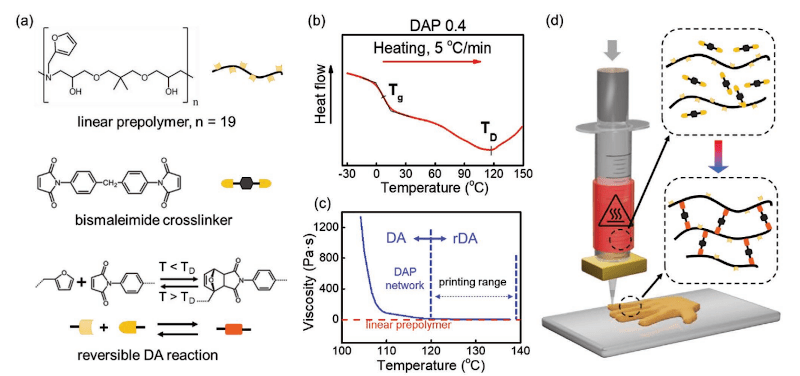Biological machines such as human and animal bodies are quite incredible. Your body seamlessly incorporates materials as different as muscle, bone, and tendons into an integrated whole. Now Texas A&M researchers think they can imitate nature using polymer networks that have a tunable stiffness. As a bonus, similar to biological devices, the material spontaneously self-heals.
The trick relies on the Diels-Alder reaction which is a cycloaddition reaction of a conjugated diene to an alkene. Diels-Alder-based polymers or DAPs will bond together even when they have different physical characteristics and they undergo a reversible reaction to heat which offers shape-memory and healing capability.
The polymer takes the form of a liquid, and a Makerbot Replicator 2X fitted with a custom syringe system did the printing. Different syringes with different materials were put in during layer changes. Different polymer crosslinkers produce different physical properties in the cured polymer.
From what we can tell, this is probably not ready for prime time yet. But it does show that we still have a lot to learn on the best materials to use for creating 3D objects via additive manufacturing. We spend a lot of time thinking about 3D printing materials. While we used to do a lot of ABS, PLA is more in vogue, today.















Enter : Westworld
Can’t wait to 3D print our own Yul Brynner.
This polymer network could make a hard man humble, it has everything but Yul Brynner.
I print exclusively in PET-G nowadays. A lot easier to work with than ABS (apart from combining prints together… Solvent welding ABS is neat) and not as brittle as PLA.
Loctite sells a 2 part plastic bonder (activator and superglue) works with PETg. Methylene Chloride works well for solvent welding PETg, but it’s a carcinogen among being deadly to breathe over time. Which is why products (mostly epoxy cleaners and adhesive removers) containing it were was taken off of the consumer market last year because too many people despite labels on the front of the container would not stop using it in enclosed spaces (apparently stripping bathtubs while still in the bathroom). I haven’t tried the replacement epoxy cleaners, but those may work as well.